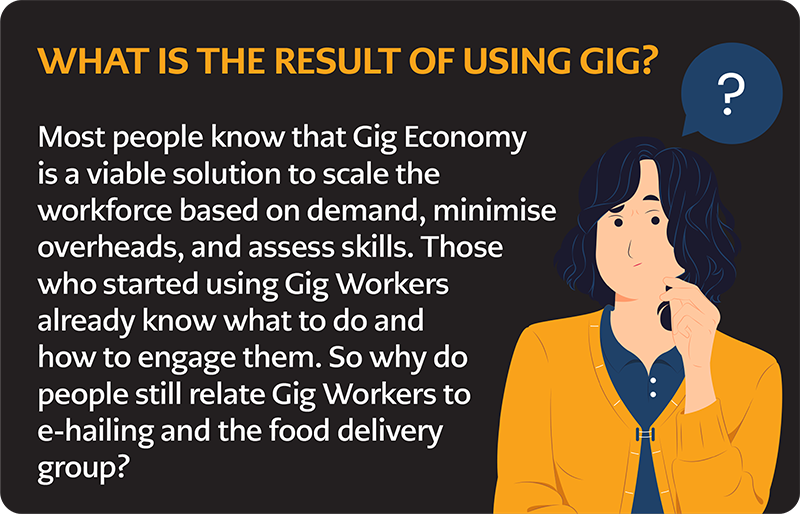
This week, a person asked me what exactly Gig Economy is. She understood Gig Workers' original context but was challenged by others who related it to e-hailing or food delivery. She is not alone. At the same time, one of our local Malaysian institutions defined the Gig Economy as providing services through a digital platform and referred to the food delivery and e-hailing work.

So, are we satisfied with the above responses? Since the above is an AI chatbot, let me explain from the experts' perspectives.
What do other institutions say?
- McKinsey relates it as "independent workers who perform different types of jobs. For example, short-term placement through a temporary agency, driving passengers, food delivery, tutoring other products, short-term renting personal property, creative jobs such as acting or writing, and substitute teaching".
- According to the UK government, Work Economic Forum published, "if you've ever used an app to call a freelance taxi driver, book a holiday rental, order food, or buy a homemade craft, then you've probably participated in this segment of the economy". They further explained, "The Gig Economy involves the exchange of labour for money between individuals or companies via digital platforms that actively facilitate matching between providers and customers, on a short-term and payment-by-task basis".
While they define the gig economy logically, many still generally refer to e-hailing or food delivery. On the other hand, when I looked into the renowned free-market platform providers, they had many other professions listed.
- Upwork is one of the world's largest freelancing marketplace platforms, and its mission is to create an economic opportunity so that people have better lives. They become the world's work marketplace where everyday businesses of all sizes and independent talent from around the globe meet and accomplish incredible things. On their site, they connect customers with knowledgeable gig workers such as designers, videographers, IT developers, marketers, writers, translators, and others.
Similarly, other Australian free-market platforms like Freelancer.com connect skills such as programmers, website builders, marketers, and financial analysts.
People have been linking the Gig Economy and Gig Workers to e-hailing and food delivery for a long time. I am a consultant and coach; hence, I need to simplify it to make people understand and hope to change their perception of Gig Workers. So, I used Simon Sinek's Golden Circle Theory to frame my simplified understanding.
Why the Gig Economy?
In the first place, why do we have Gig Economy? UK government in the World Economic Forum explained that the purpose of having a Gig Economy involved exchanging labour for money between individuals or companies via a digital platform that actively facilitates matching between providers and customers, on a short-term and payment-by-task basis."

And this was explained further by MDPI Economic Researchers as a work scheme in a virtual environment that brings together people who can utilise their assets, knowledge, or talents to find and work on a remote project for a short-term duration without permanent employee status.

The scope of the gig economy is broad and includes numerous sectors and professions.
How are they connected?
This is how the gig platform came to place. Many businesses already know and use the free marketplace platforms to render services. However, while they know where and how to use the platform to procure Gig Workers, many people may not understand that different Gig platforms cater to various gig work engagements.
Today's most common platform in the marketplace is e-hailing or food delivery platforms. These platform providers on the application have a large customer segment and use it to create a revenue stream as their business model.
The other platform type is a gig talent procurement platform that caters solely to procuring independent knowledge of Gig Workers to perform specific tasks or work.
The platforms are built to facilitate the entire gig workers' engagement process, from matching to procuring and assigning the gig worker till completion of the job and payment. In addition, some may have additional features like assessment or even complete rating and feedback mechanisms.

What is the result of using Gig?
Most people know that Gig Economy is a viable solution to scale the workforce based on demand, minimise overheads, and assess skills. Those who started using Gig Workers already know what to do and how to engage them. So why do people still relate Gig Workers to e-hailing and the food delivery group?
The perception
Today, more than 4 million gig workers are in Malaysia. Many businesses use gig workers to render on-demand services such as transportation, delivery, packing, and housekeeping, which require fast and reliable services.

Job listing sites drive the gig economy almost entirely, such as Upwork, which matches gig workers with potential clients.
As a result, the volumes say it all; thus, these on-demand groups of gig workers superseded the other professions. We must be aware that Gig work can cater to other professions, and they can be knowledgeable, skilled professional freelancers or independent workers.
For example, one of the prominent and established banks in Singapore launched a gig platform to engage their retired bankers and women with caregiving duties to take up flexible, short-term, project-based work. They deem their retired employees with technical expertise highly valued; hence they are assigned to projects or customer services roles.
Whether we like it or not, Gig Economy is the future of work. Gig Economy can help organisations with potential underemployment issues, anticipate future generations' culture, and many more. Therefore, if your organisation is looking to establish or deploy a Gig Economy or platform, understand the business purposes so that you can determine what the organisation needs to do to achieve the desired outcome.
About the Author

Elsie Low is a Strategic People and Technology Business practitioner. She is a consultant and transformational coach, and she helps businesses start their digital transformation and gig economy journey. She believes that the future is no longer about a legacy business model; hence, business needs to transform and to do that, one needs to Lead, Think and Govern their digital journey with the right fundamentals.






